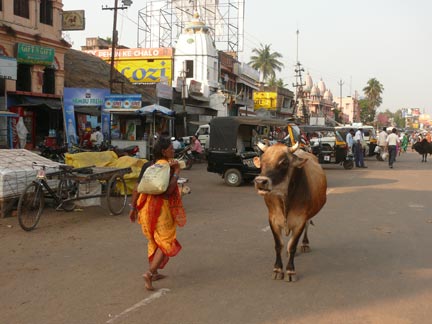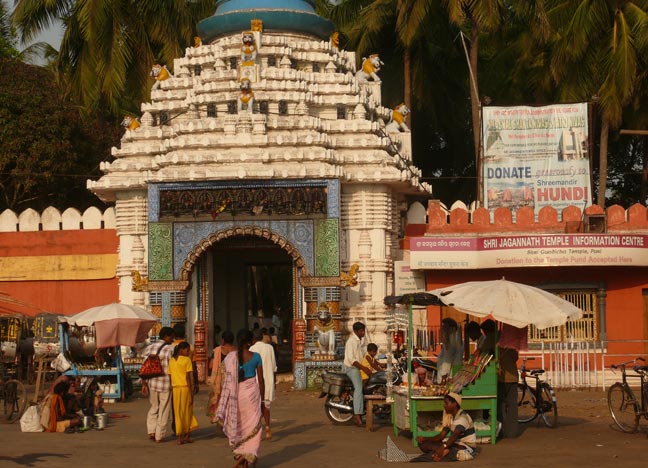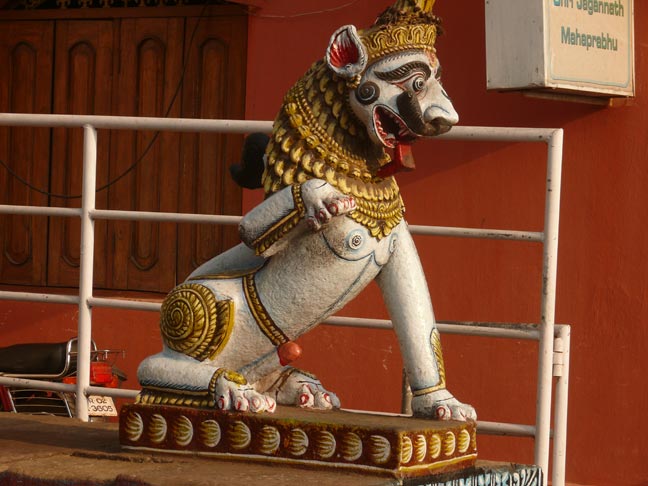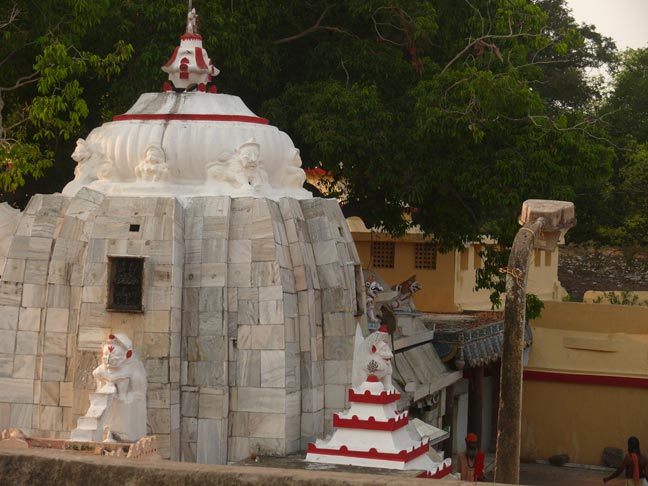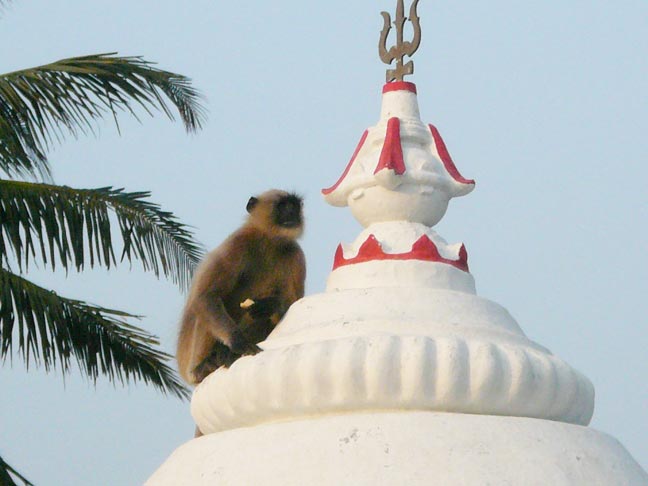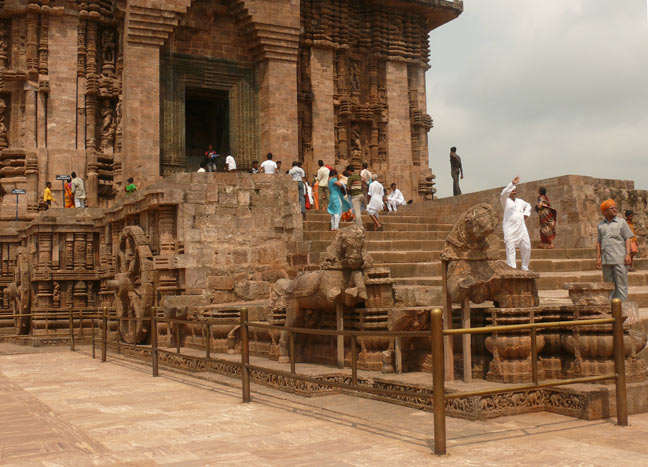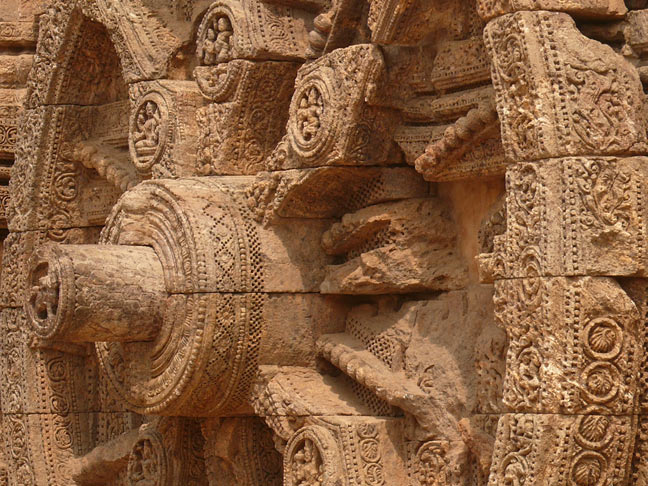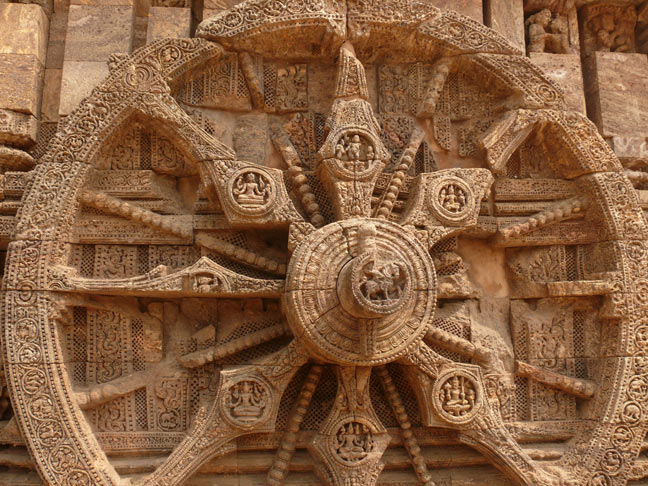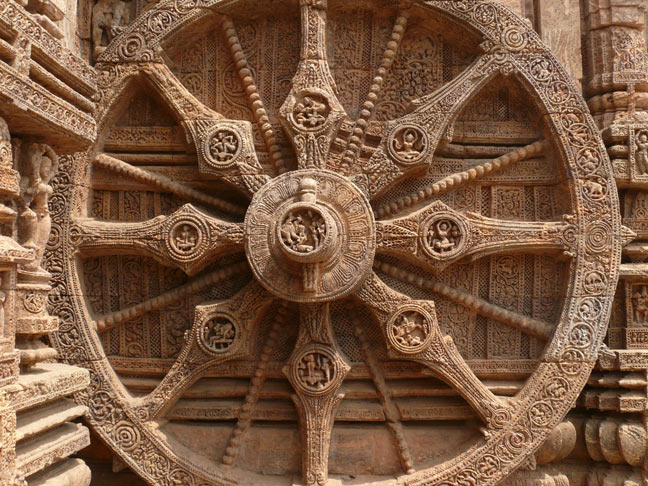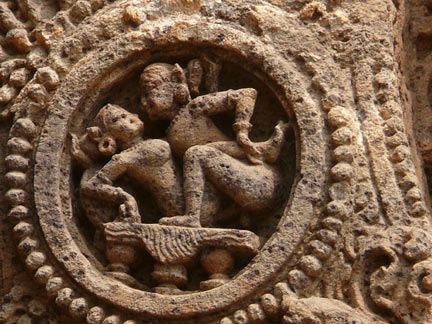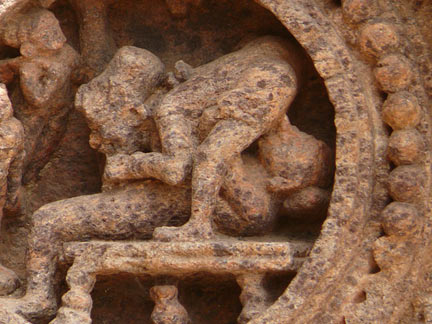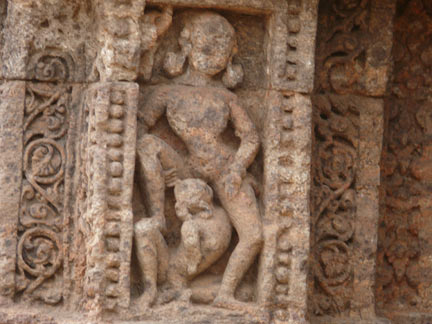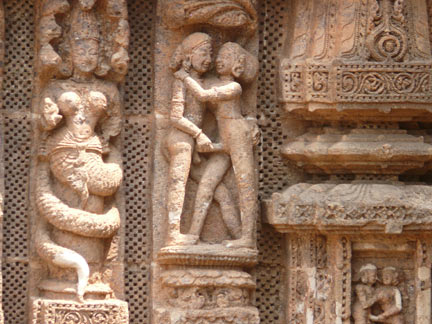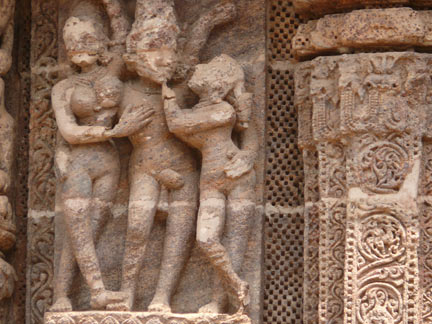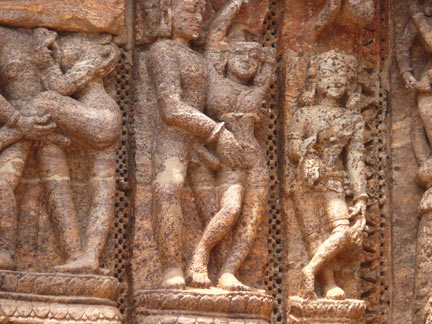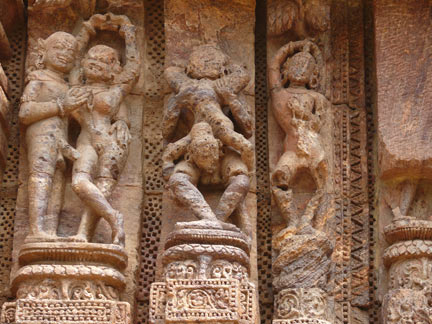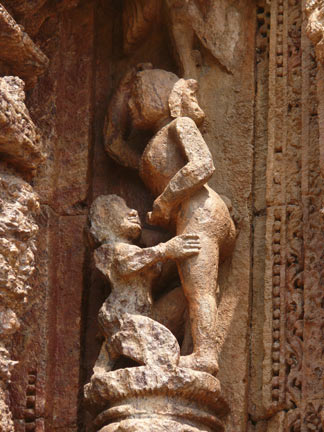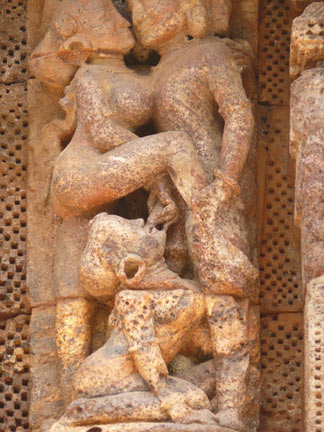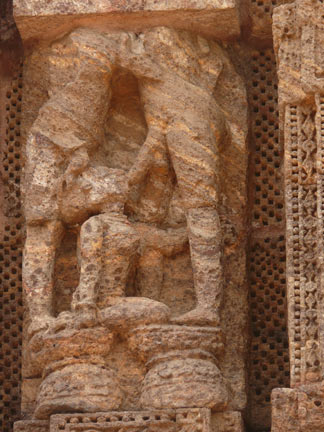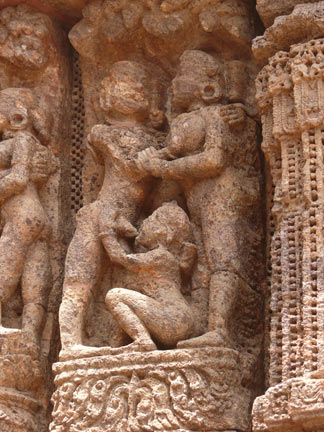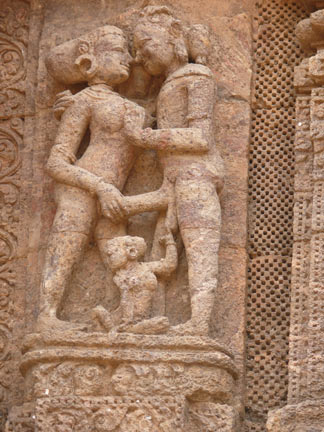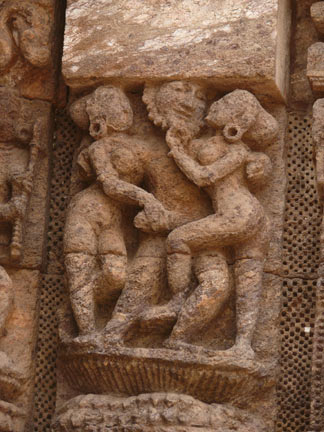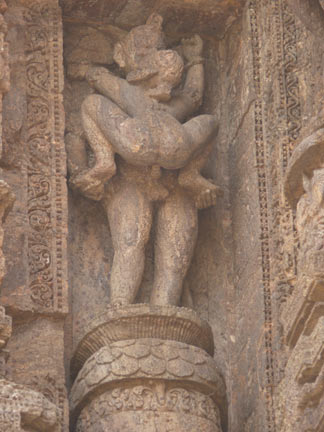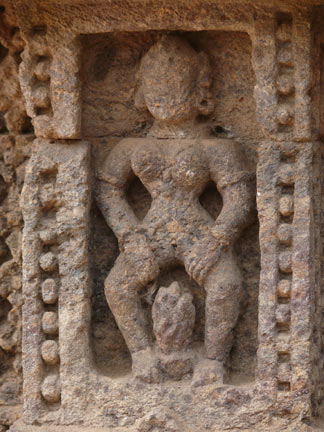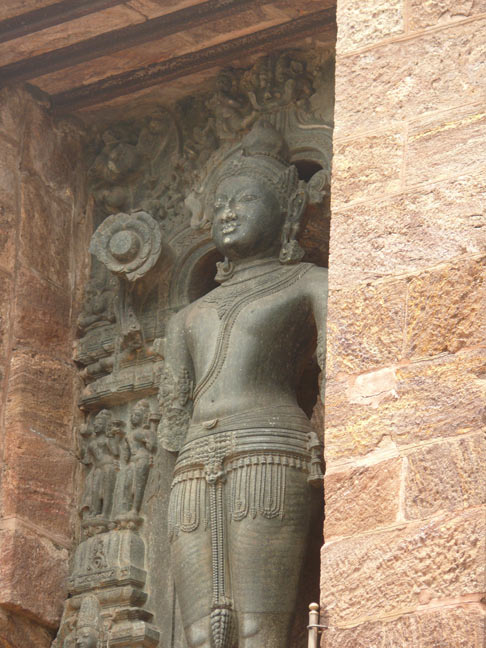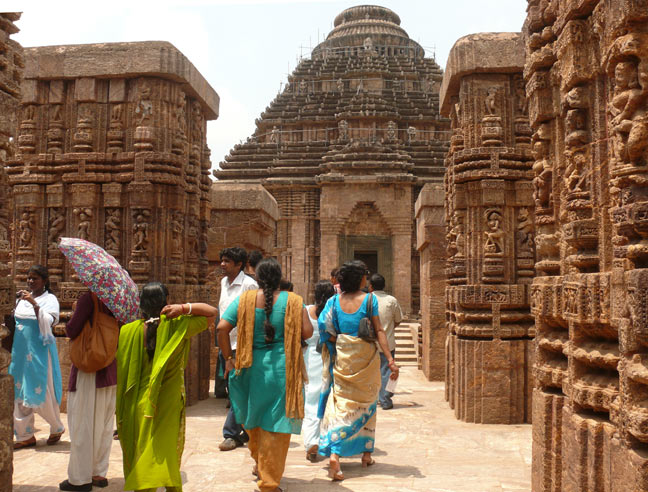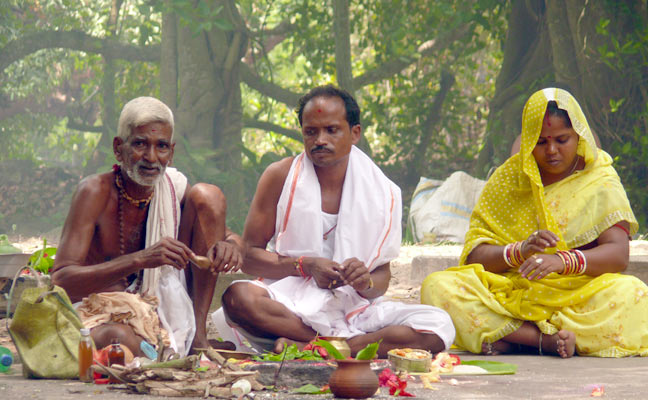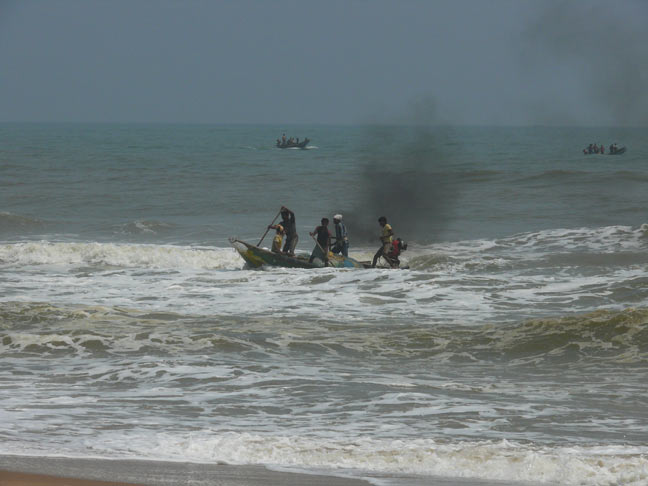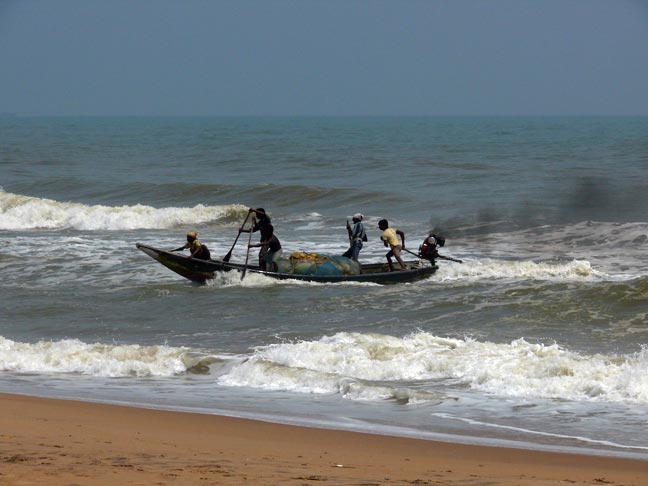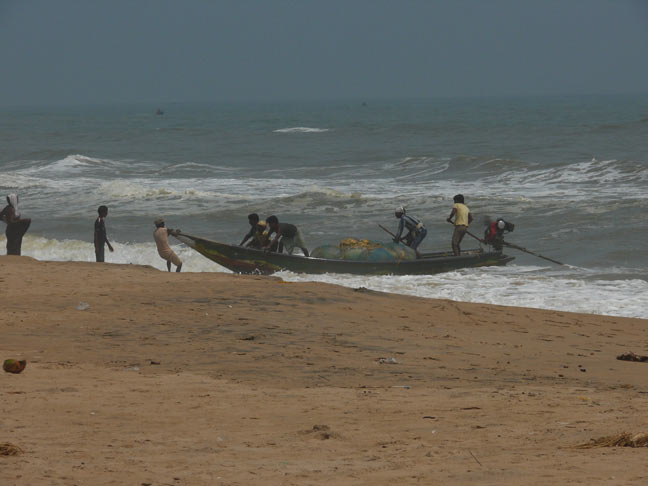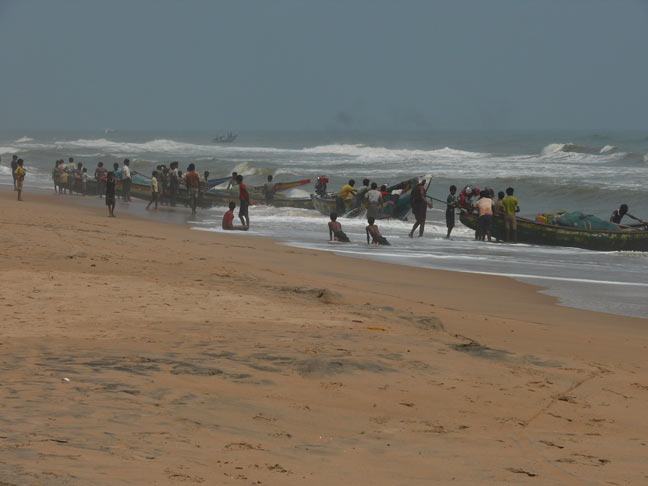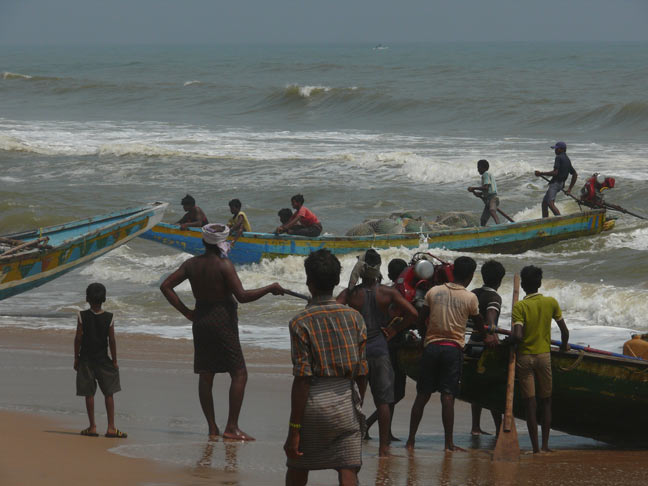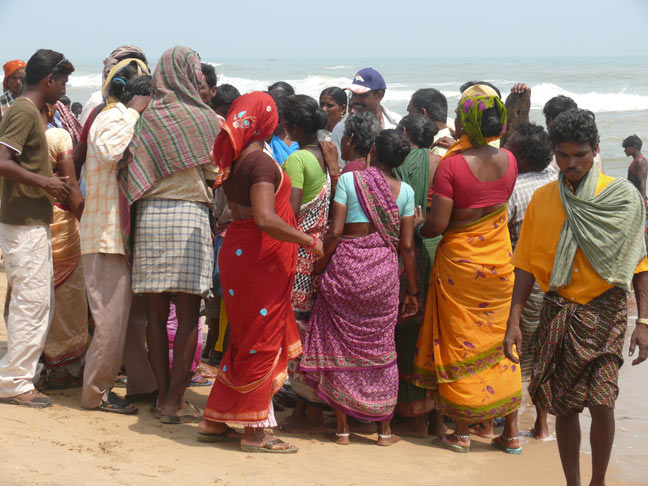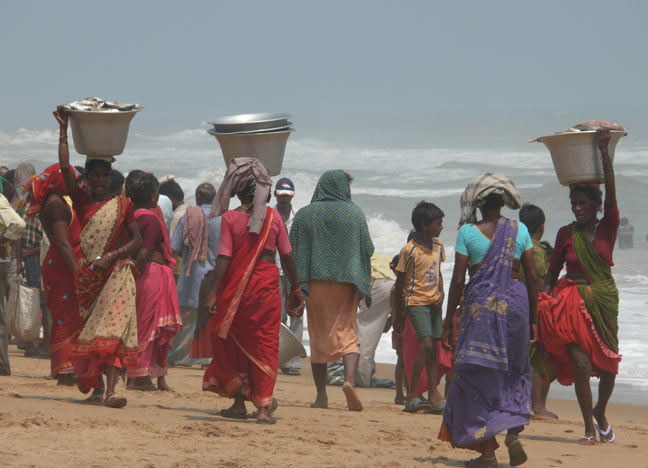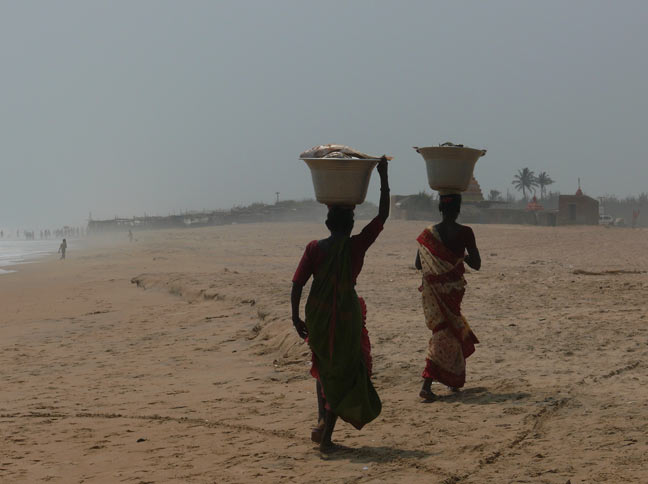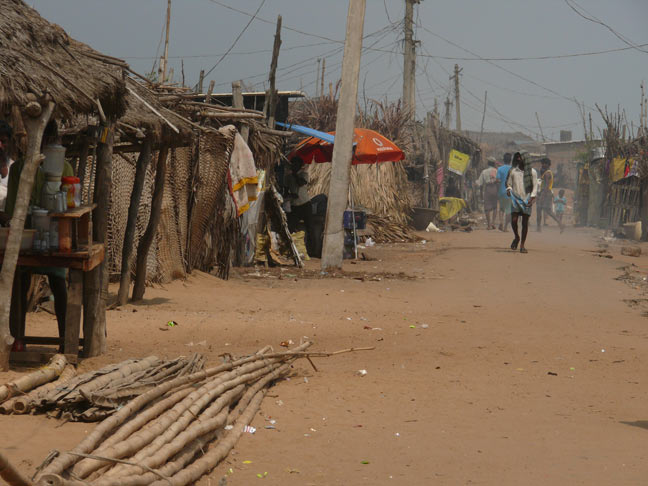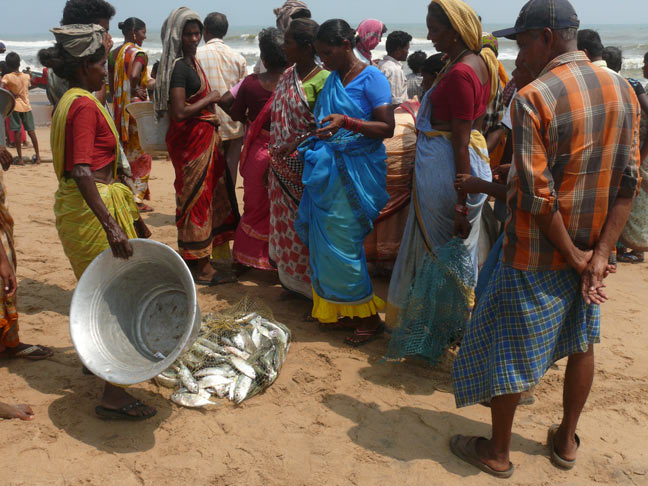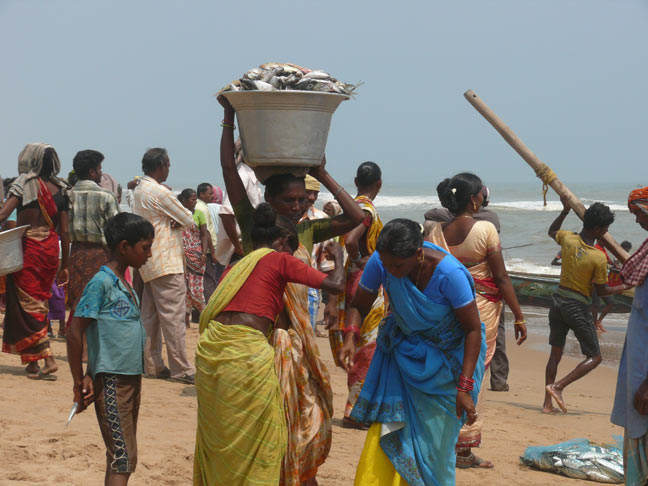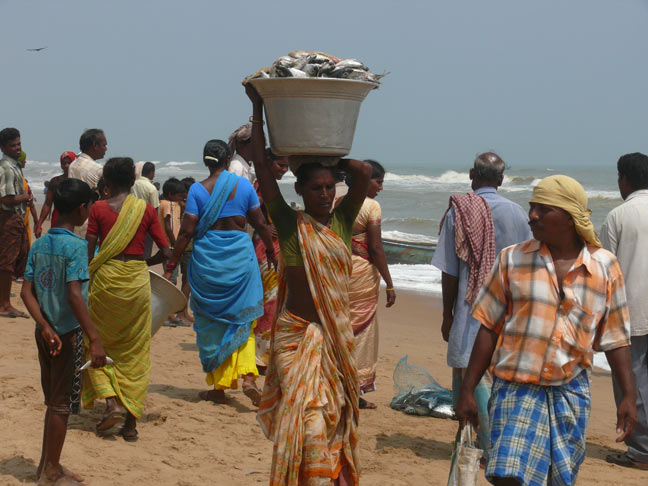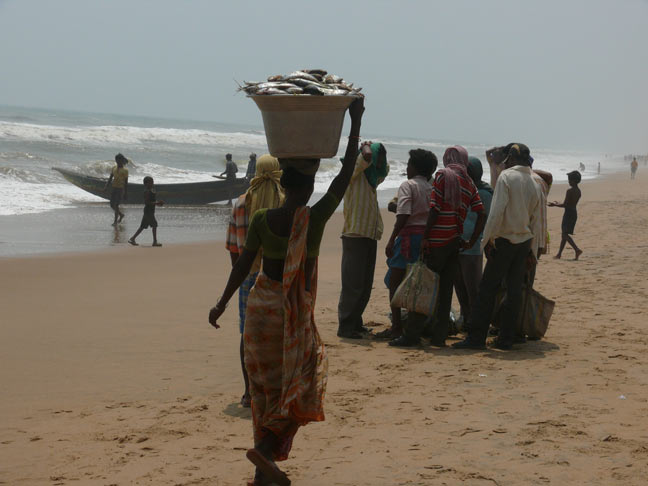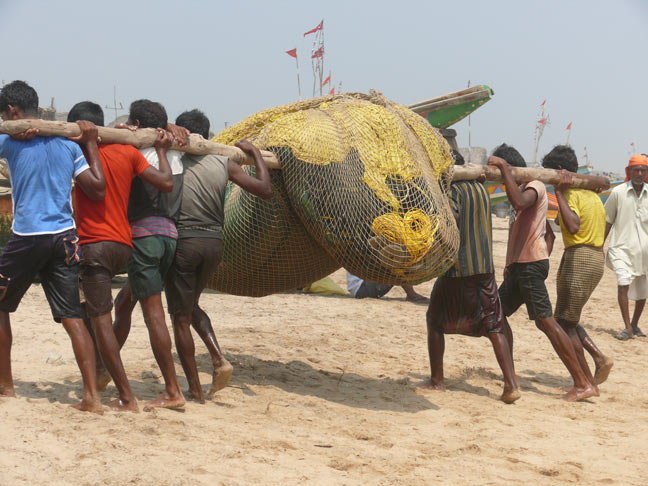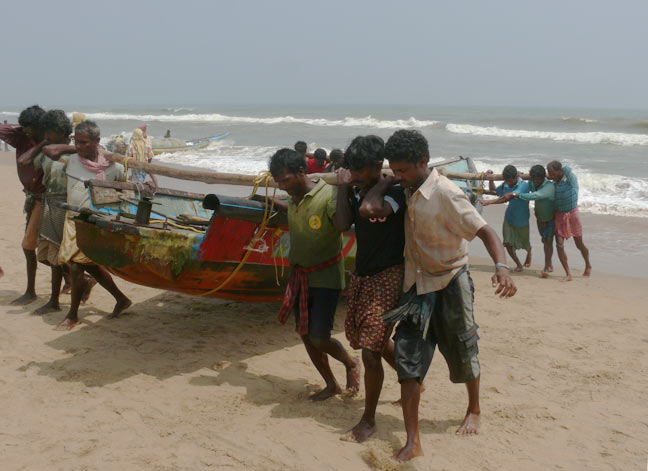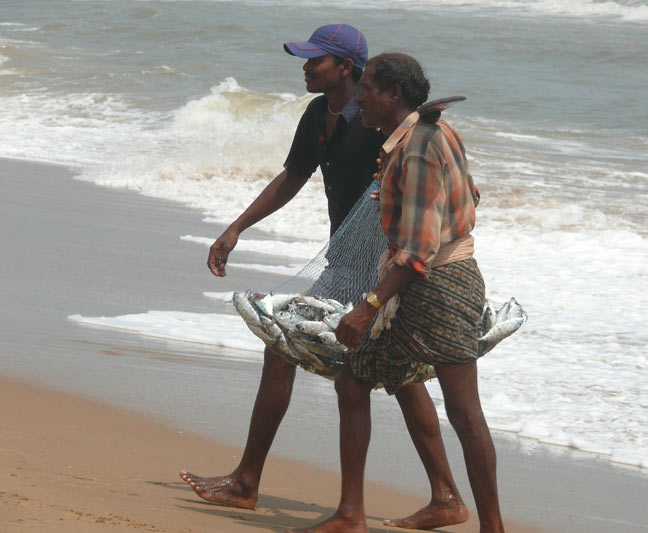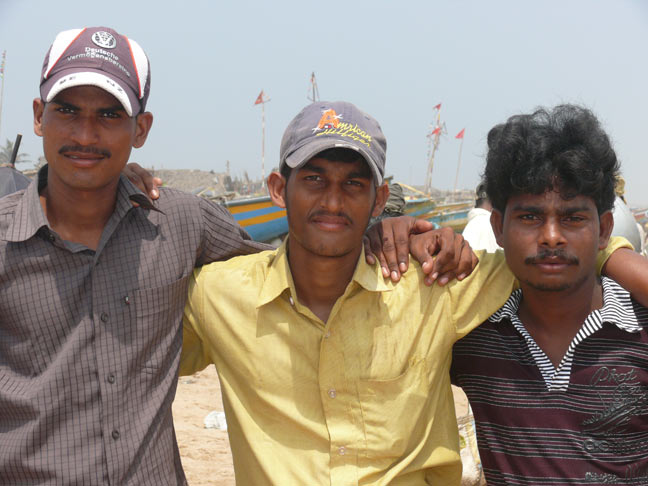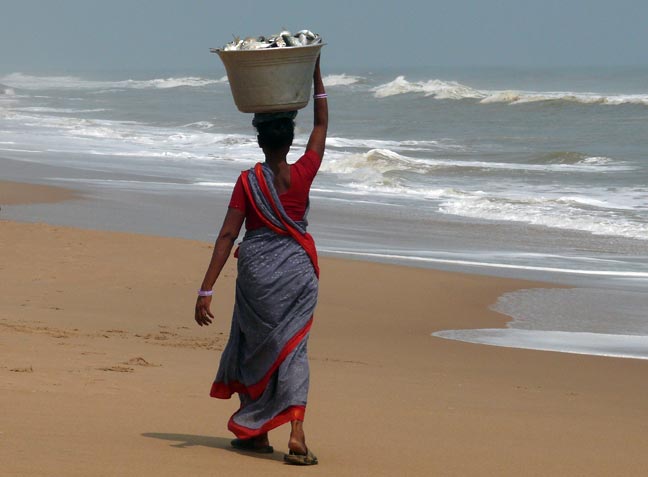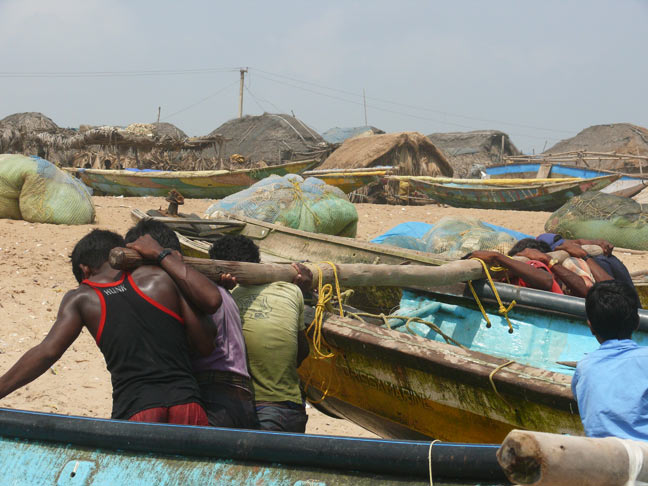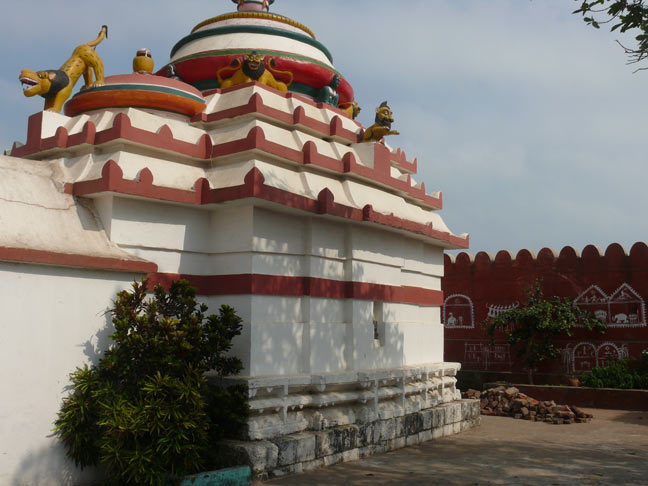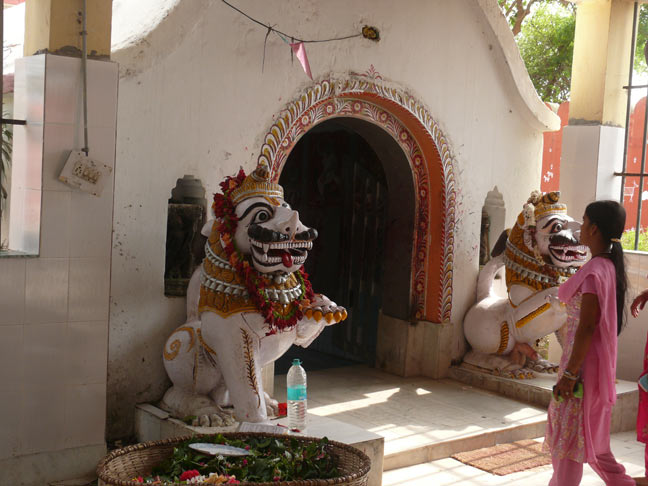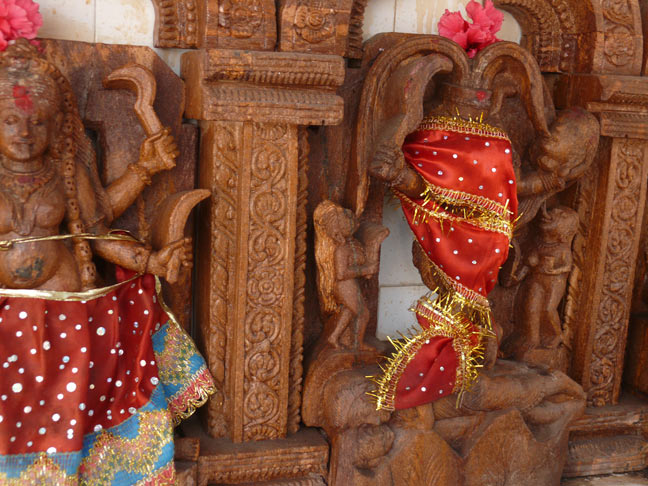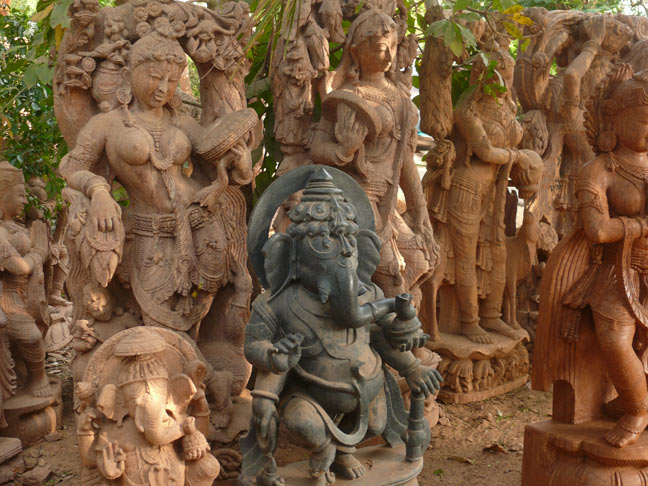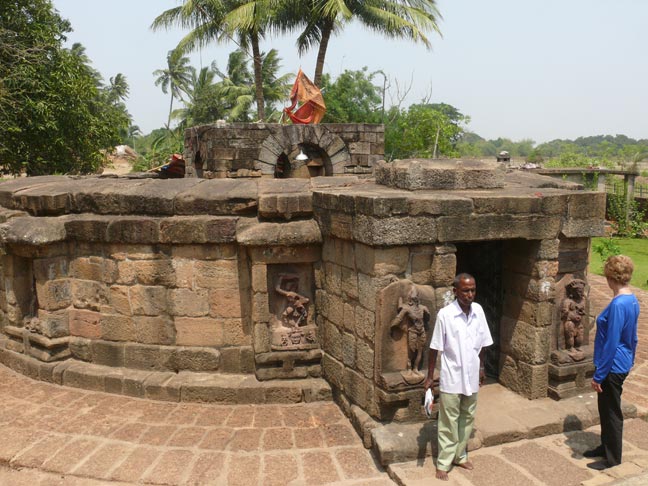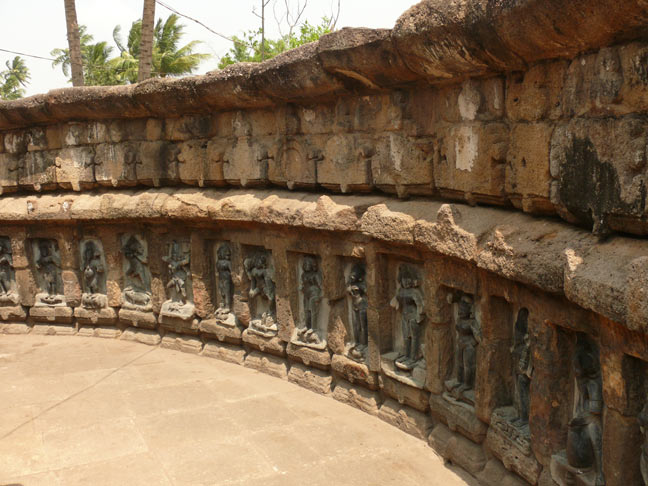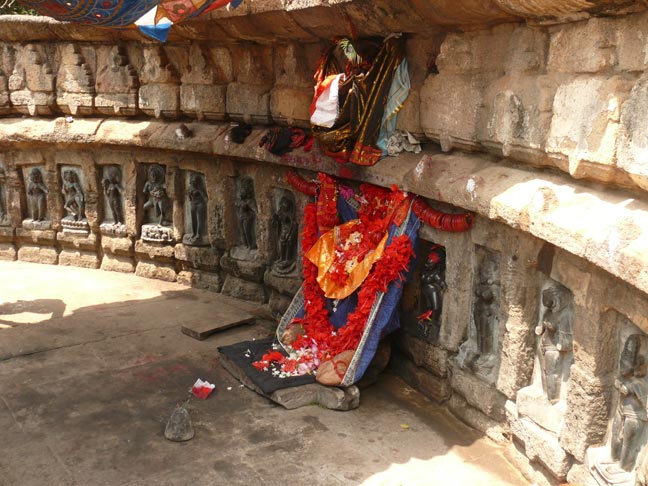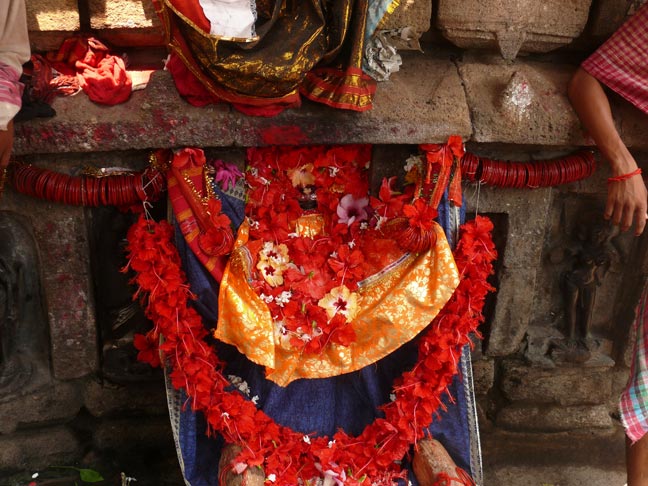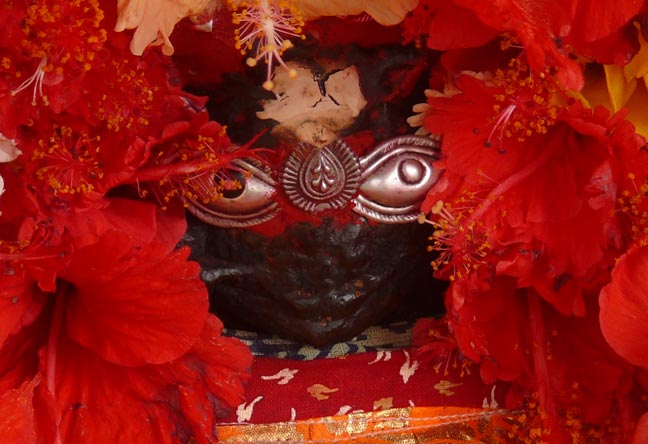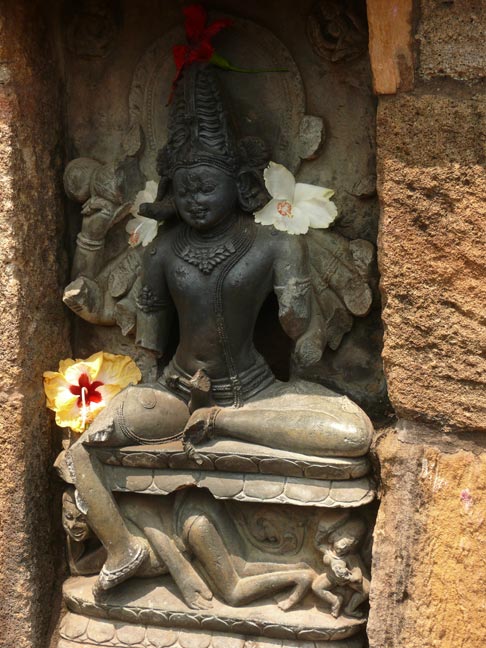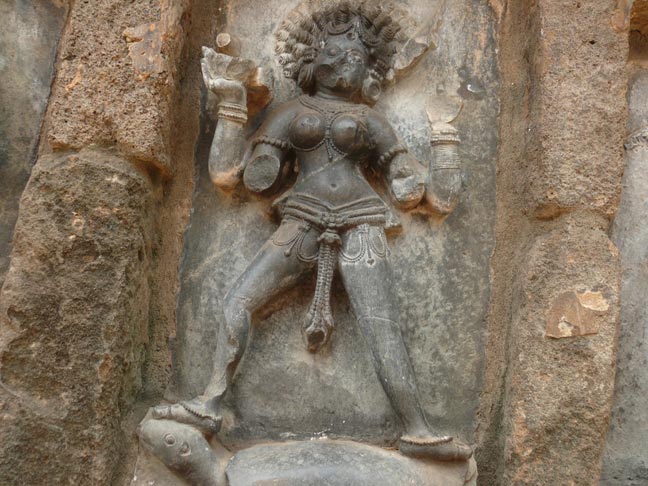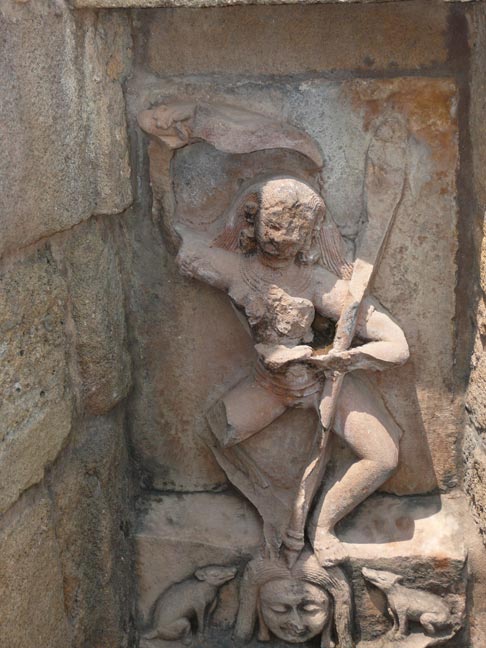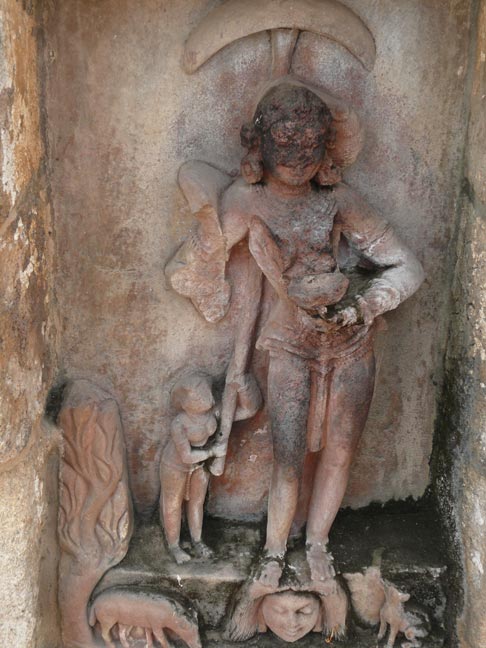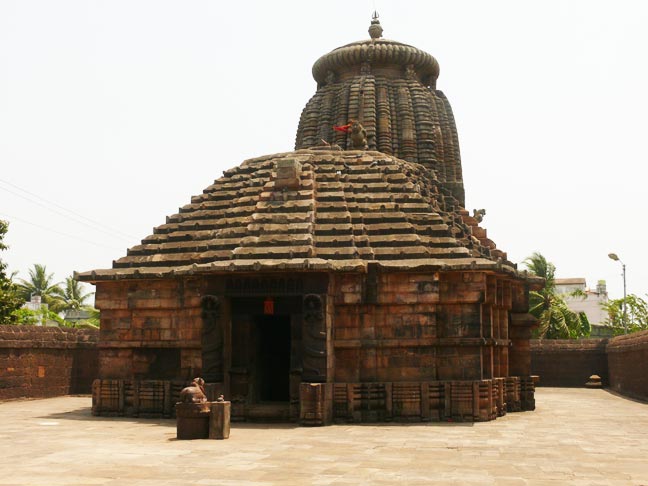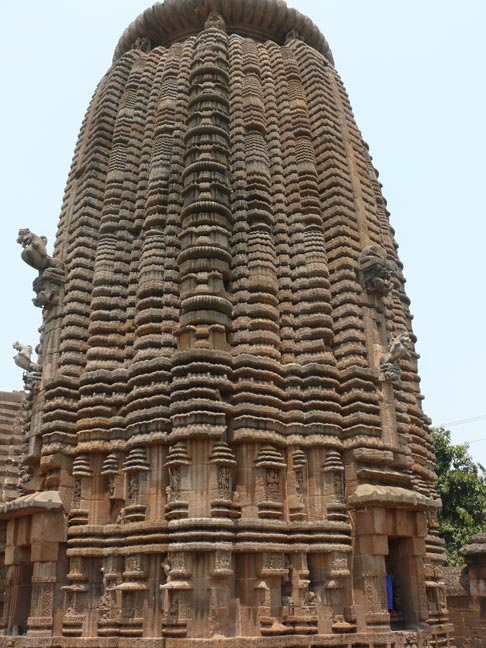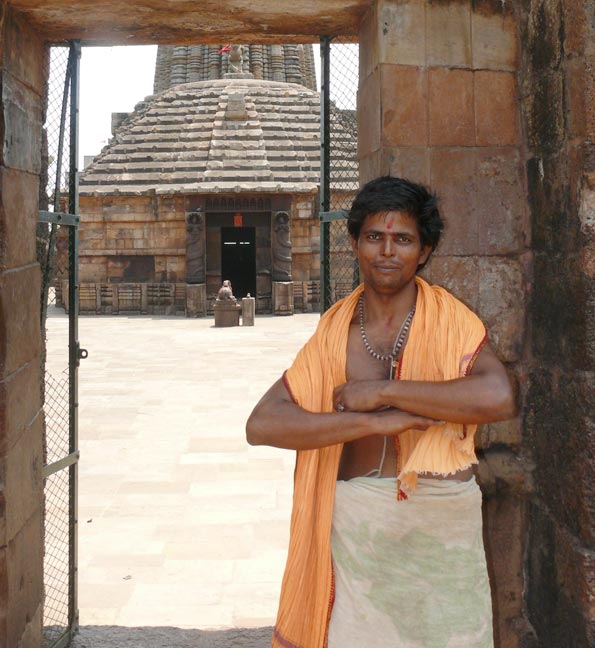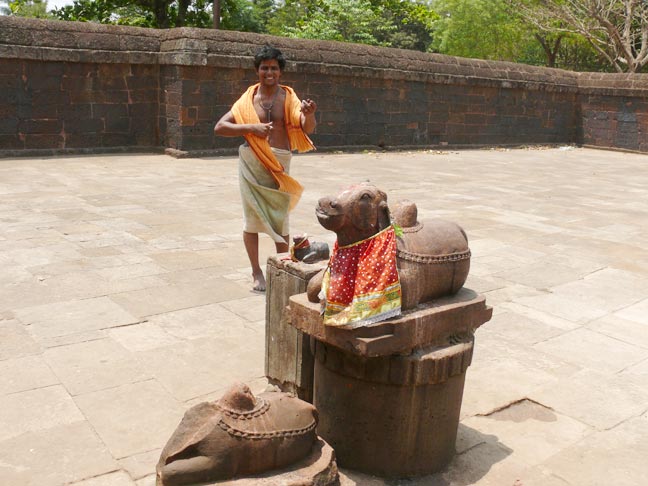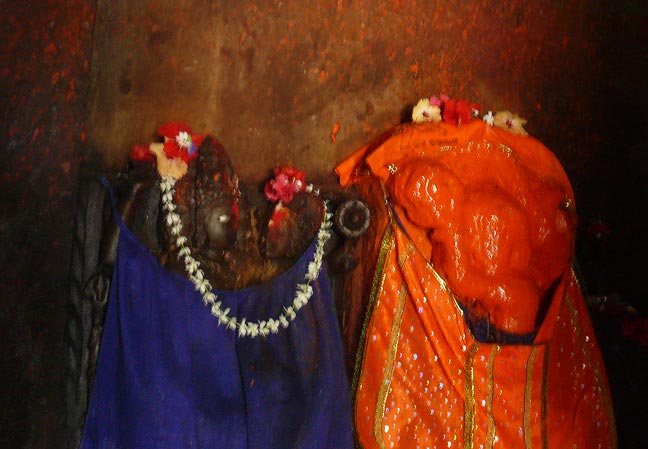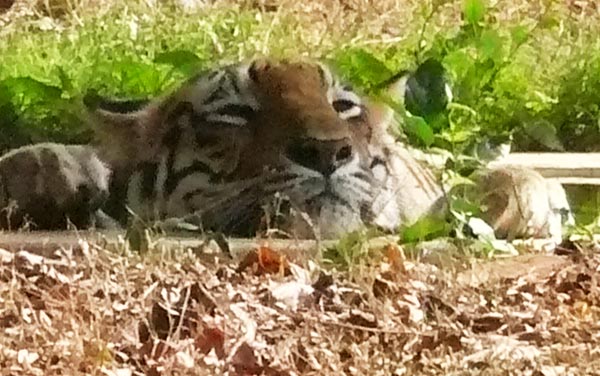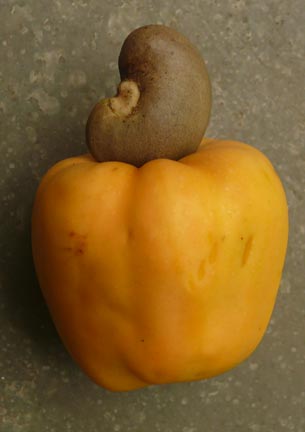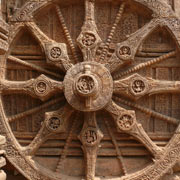|
|
|
After
a few days in Kolkata we flew to Bhuboneswar in the state of Orissa. One of
the most stunning sites in all of India
is the sun temple in Konark (above), a UNESCO World Heritage Site. |
|
We stayed a few days
in Bhuboneswar at an incredibly special hotel. We first visited sites in
Bhuboneswar and then Buddhist excavation sites north. Later, we moved south
to Puri and visited Kornak and Lake Chilika. We traveled a total
of 400 mi in Orissa. |
|
|
|
Our hotel in
Bhuboneswar (Mayfair Lagoon) was really plush. Just outside of our room was
this sitting area on its man-made lagoon. That tiger getting a drink (barely
visible to right of photo) isn’t real, of course… |
|
We watched this bird perched on an alligator catch little
fish. The alligator isn’t real either, of course… |
|
|
On the park-like
grounds of the hotel was this little Hindu temple visible from our room where
a Hindu priest performed evening rituals. This was real. |
|
|
|
More than 400
temples remain of the 7,000 that are said to have once embellished the city
of Bhuboneswar. The best preserved of the early group of Orissan temples
dating from the 7th c. CE is Parasurameswar temple. Examples of lavish
sculptures on the temple walls are below: the superb potbellied Ganesha and
his brother Karttikeya sitting on his vehicle, the peacock. |
|
|
|
|
|
The inner sanctum is
quite typical for a Shiva temple, a lingam protected by cobras located in a
yoni. The Hindu priest is adding flowers (offerings). Hindu priests are
often more hereditary custodians than trained religious specialists. They
maintain the facilities and grounds and perform simple rituals. They must
come from the top caste, the Brahmin caste. |
|
The nearby 10th
c. Muktesvara temple is one of the jewels of Orissan temple architecture
notable for its exquisite sculptures and elegant proportions. |
|
|
|
This beautiful
gateway is decorated with reclining female figures. |
|
Inside the temple, a
Hindu priest is making offerings with flowers to the lingam, cobra, and yoni. |
|
|
|
In one of the temple
niches, we found this colorful altar of the Jagganath cult that will be
described later in the Puri section. Jagganath (the Lord of the Universe) is
on the right, his little sister Subhadra next to him, and his brother
Baldhadra on the left. They are believed to be of tribal origin but have been
absorbed into the Hindu pantheon with Jagganath as an incarnation of Vishnu.
That they are displayed in a Shiva temple doesn’t matter. One of the
attractive features of Hinduism is the non-dogmatic flexibility to absorb any
religion it encounters. This picture is also used for the background for this
page. |
|
The 11th
c. Rajarani temple is another exquisitely carved and decorated building. |
|
|
|
Remarkable are the
tall and slender female figures carved in high relief. |
|
|
|
|
|
Women preparing
temple offerings. These women have met here every Tuesday to do this together
for many years! |
|
Outside of the 10th
c. Brahmeswar temple we observed people worshipping this wrapped image
(perhaps Kali, enlarged below). |
|
|
|
|
|
The 11th
c. magnificent Lingeraj temple is unfortunately inaccessible for non-Hindus
but can be looked into from an outside platform. Its grandeur lies in its
towering 180 ft spire with dramatic vertical ribs. The temple’s large
courtyard has more than 100 smaller shrines. |
|
|
|
Courtyard of the
Lingaraj temple (taken with a tele lens). |
|
|
This vehicle is used for religious processions. |
|
The late 8th
c. Vaital Deul is one of the oldest Shakti (sacred force, personification of
divine feminine power) temples. A striking feature is the semi-cylindrical
shape of its sanctuary tower. The outer panels
show Hindu deities, mostly Shiva and Parvati. Another fascinating
feature of the temple is its Tantric association marked by eerie carvings in
the sanctum and.. |
|
|
|
|
|
..enshrined in a central niche an eight-armed Chamunda, a
terrifying form of the goddess Durga. |
|
|
|
Parvati in her
Shakti form and… |
|
… a 10-armed dancing
Shiva. |
|
|
Shiva (after having
Viagra for breakfast). |
|
|
|
This Ganesha image
is painted and serves as a little altar. |
|
The small entrance
to the inner sanctum with terrifying images (below). Most broadly, Tantra
is a psycho-physical discipline which seeks to release the latent powers of
the mind and sensory inputs. Tantra emerged in
India around the middle of the first century CE and eventually affected
Buddhism, Islam, Judaism and Christianity. The religious mysticism found in
most major religions is a manifestation of Tantra. |
|
|
|
Inside the dark
inner sanctum, the presiding deity Chamunda sits on a corpse flanked by a
jackal and an owl and decorated by a garland of skulls (only partially
visible because of the drape). |
|
Chamunda holds a
snake, bow, shield, sword, trident, thunderbolt and an arrow and is piercing
the neck of the demon (details under the drape). There are other
images with skull cups filled with the blood of a person whose severed head
lies next to it. These Tantric
practices involved human sacrifices in the past. |
|
|
|
The main Hindu
priest of the temple makes his worldly living by selling Siemens appliances.
When Juergen told the priest that he once worked for Siemens, the priest
immediately tried to take advantage of Juergen’s long gone connections. That
newly-established friendship made it possible for Juergen to take pictures in
the inner sanctum. Hope Chamunda didn’t
get mad. Otherwise Juergen’s skull may be used… The stone carvings
on their right show Buddha images. |
|
A few miles north of
Bhubaneswar are the twin hills of Udaigiri (sunrise hill) and Khandagiri
(broken hill) which were honeycombed to make retreats for Jain monks in the 1st
c. BCE. |
|
|
|
The two-storied Rani
Gumpta cave (above and on the left) has lavishly sculpted friezes. |
|
The Bagh Gumpta cave
is shaped like the open mouth of a tiger. |
|
|
|
There were many of
these guys around expecting bananas from the visitors. |
|
We traveled north to
Ratnagiri (45 mi NE of Bhubaneswar). Ratnagiri is one of the three Buddhist sites
in this area and was a major university and monastic establishment between
the 7th and 11th c. CE. The picture on the
right shows a large number of votive stupas. |
|
|
|
Part of the
monastery with a beautiful door. |
|
An impressive colonnade
around the monks’ cells. |
|
|
|
Buddha image flanked
by other Buddhist deities. |
|
The second of the
three Buddhist sites in this area is Udaigiri (same name as the Jain site
just 4 mi north of Bhubaneswar). It dates from the from the early centuries
CE to the 13th c. |
|
|
|
Large Buddha image. |
|
Remains of brick
stupas at Udaigiri. |
|
|
|
The final site is
Lalitgiri is believed to be the oldest of the three sites. Interesting are
the terraced stone platforms on the left. All three sites are
still being excavated. |
|
Five miles south of
Bhubaneswar is the site where King Ashoka fought the bloody battle of Kalinga
in 260 BCE. The carnage and misery resulting from this battle motivated the
King to shop around for some good karma. He turned from military to religious
conquest embracing Buddhism and making it the state religion. This reminds us a
little bit of emperor Constantine embracing Christianity and making it the
state religion of the Roman empires in 313 CE (even though his motive was not
remorse). In both cases, world
religions evolved from humble sectarian movements that otherwise might long
be forgotten. |
|
|
|
Ashoka publicized
his new maxims in rock edicts installed in different parts of the empire. One of these is on
the left (at the base of Dhauli Hill) in which the emperor declares: “All men
are my children,” and orders his officials to ensure impartiality,
non-violence, justice and compassion in administration. The top of this rock
is sculpted into… |
|
…an imposing
elephant head symbolizing the Buddhist dharma (teachings). This is one of the
earliest sculptures found in the subcontinent of India. A truly remarkable
site, especially as we’re fascinated by early Buddhist iconography. |
|
|
|
The huge white
Shanti Stupa (Peace Pagoda) at the top of Dhauli Hill was built by Japanese
Buddhists in the early 1970s honoring Ashoka.. |
|
Buddha image at the
Shanti Stupa. |
|
|
|
Pipli (12 mi from
Bhubaneswar) is the capital of appliqué craft in Orissa. Appliqué art
consists of cutting colored cloth in the shape of animals, birds, flowers or
other decorative items and stitching them on another piece of cloth. |
|
Timeless
transportation. |
|
|
|
River bank scene
with the ladies doing laundry and the man fishing with a bell-shaped net. |
|
Heading south to
Puri, we visited Raghurajpur, a
heritage crafts village. |
|
|
|
|
|
Many of the houses
are painted with scenes like the ones above, right and below. Only mineral
and earth colors are used in the paintings together with plant gums for
binders. |
|
|
|
|
|
This is one of the
many beaches in Puri. It was a hot, muggy evening with temperatures in the
upper 90s F. Bathing suits are not worn and people wade in the water only
dressed. These are mostly
people from Kolkata getting away from the heat there. There is a striking
contrast between the explicit temple iconography and the extreme modesty in
the present dress code. |
|
|
|
We traveled to Lake
Chilika and took a long boat
ride on the lake. We saw the rare Irrawaddy dolphins (though not close enough
for good pictures). |
|
At the lake Chilika
we watched those robot-like looking crabs fighting over a dead fish. We saw the two
different kinds of Kingfishers below. |
|
|
|
|
|
It was hot and humid
in Orissa. Temperatures were often above 100 F. The water buffalo on
the right knew how to handle the heat. |
|
|
|
We spent a few days
in and around Puri. This is one of
India’s most important pilgrimage sites dominated by the towering 12th
c. Jagannath temple, left. A fascinating cult
has grown around Jagannath, the Lord of the Universe, an incarnation of
Vishnu. At the temple, 6,000 resident priests
perform elaborate daily rituals of bathing, dressing and worshipping the
image of Jagannath together with those of his brother Balabhadra and sister
Subhadra. |
|
Sumptuous meals are
offered to the three deities five times a day prepared daily by 400 temple
cooks. During the spectacular Rath Yatra (chariot festival) in June/July, the
deities are taken in a procession in 45’ tall mammoth wooden chariots, pulled
by thousands of devotees. These chariots are built new every year. The word juggernaut
is derived from the size and unstoppable force of the Lord Jagannath chariot. |
|
|
|
We walked along the Grand Avenue called Bada Danda between
the Jagannath temple and the Gundicha temple or the garden house of Jagannath
(distance between the two temples is about 2 mi). The people, the animals, the food, the colors and the
sights were so fascinating that we assembled pictures below to show the
atmosphere. |
|
|
|
|
|
|
|
|
|
|
|
|
|
|
|
|
|
|
|
|
|
|
|
|
|
|
|
|
|
|
|
|
|
|
|
|
|
According to our guide, the “tongue” sticking out from
the back of the cow is a frequently seen abnormality. |
|
|
|
|
|
|
|
|
|
|
|
|
|
|
|
|
|
|
|
|
|
|
|
|
|
|
|
The (blue) Reliance store on the left reactivated our
expired USB data modem (Reliance is one of India’s cell phone and wireless data
providers) that we used in our laptops to stay connected to the internet.
Coverage is so good, that even in the remote areas of Sikkim we always had
internet access. |
|
|
|
|
|
Yvonne and our guide in Orissa. Below left, we took a tuk-tuk for part of the Bada Danda. |
|
|
|
|
|
|
|
|
|
|
|
|
|
|
|
|
|
|
|
|
|
|
|
|
|
|
This is the Gundicha
temple at the end of the Rath Yatra procession. It remains vacant most of the
year and is occupied by Jagannath and his siblings for nine days during the
festival. It is said that to
honor the devotion of the Queen Gundicha (wife of the Jagannath temple
builder) that Lord Jagannath, Balabhadra and Subhadra leave their regular
abode in the main temple and spend a few days in this temple built in their
honor. Our local guide told
us that this is the place Jagannath was born and he wants to return there
once a year. Take your pick. |
|
One of the guardians
of the temple. |
|
|
|
The Lokanath temple
is about 2 miles from the Jagannath temple. The access to the temple is lined
with beggars (not a rare occurrence). |
|
The presiding deity
Lokanath, a lingam, always remains under water in a small square vat. One
night of the year all the water is bailed out which makes the top of the
lingam visible to the worshippers. |
|
|
|
One of the temple
towers (with the Shiva trident) was guarded by this fellow. As it’s the case
with many Hindu temples, non-Hindus are not allowed inside. We managed to enter
and photograph enough Hindu temples that we have a pretty good impression of
the inside appearance and atmosphere. |
|
|
The Sun Temple in
Konark is one of India’s great architectural sites. It is a temple to the Sun
God Surya built as a gigantic chariot with 12 pairs of wheels to carry the
sun god o his daily journey across the sky. This building is just a small
part. Built in the 13th
c. by King Narasimhadeva of the eastern Ganga dynasty the temple is also
remarkable for its superb sculptures. Gods and demons, kings and peasants,
elephants and horses jostle for space on its walls with many quite explicit
erotic scenes. Konark is a UNESCO World Heritage Site. |
|
|
|
|
|
Two of the horses
symbolically pulling the chariot. |
|
One of the twelve
pairs of wheels with deities depicted in the medallions. |
|
|
|
Same wheel as above. |
|
This exquisitely
carved wheel shows erotic scenes. The 8th spoke (counting clockwise
from the top vertical one) and the 6th are enlarged below. The
erotic sculptures of Konark are a celebration of the joys of life. |
|
|
|
|
|
|
Following a collection of the famous sculptures of
Konark. They are as uninhibited as the ones we saw at Kajuraho (which date
from 950-1150 CE). |
|
|
|
|
|
|
|
|
|
|
|
|
|
|
|
|
|
|
|
|
|
|
|
|
A woman squatting
over a flame to sterilize herself after giving birth. |
|
||
|
|
|
|
||
|
A majestic image of
the sun god Surya. |
|
|
|
Back end of the
chariot. |
|
|
|
|
|
Pilgrims (?) on the
temple grounds. |
|
Just a few miles
east of Konark we spent some time on the Chandrabhaga beach. The village located there
primarily supports itself by fishing. The men go out in
simple boats that are launched from the beach. They also land at the sandy
beach that’s pounded by heavy surf. Watching their landings is quite a
thrill. The women carry the
fish to market. |
|
|
|
Above, left and
below are landing shots. It requires considerable skill and accurate timing
to beach the boats at correct angles. |
|
|
|
|
|
|
|
|
|
|
|
The catch is
inspected and auctioned off as soon as it’s unloaded. While all the
fishing is done by men, the bidding, purchasing and carrying the fish away is
done by women. These people were
very trim and muscular from their hard work. They were also very
playful with each other. We saw one woman playfully use her foot to push a
man (almost) over when he was bent over doing something causing everyone to
laugh. |
|
We were told that
the fully loaded buckets that the women carry away may weigh as much as 110
lbs. |
|
|
|
It’s amazing how
graceful the women carry these heavy loads through the sand over considerable
distances. |
|
The fishing village
itself consists mostly of these huts. |
|
|
|
|
|
To put the bucket of
fish on the head requires two women to lift the bucket while the carrier
squats a bit. All three then position it on the head. When we watched them do
this it was obvious that the bucket was very heavy. |
|
|
|
|
|
|
|
|
|
After returning from
the trip, the men carry the boat, outboard motor and the nets to safe ground
near the village. Everyone works
together. |
|
|
|
|
|
A boat’s entire
catch. |
|
|
|
|
|
These fishermen
wanted to pose and have their picture taken. We thought their
caps were interesting. The one on the left
says “Deutsche Vermögensberatung” (German Wealth Management). We doubt that the
guy has his “wealth” managed by that outfit. |
|
|
|
|
|
|
|
This is the size of the
fish they’re catching. |
|
|
|
Three miles outside
of Konark on the banks of the Kusabhadra river is the Ramachandi Temple. |
|
There is a lengthy
story behind this temple which involves the goddess Ramachandi outwitting a
17th c. Hindu Brahmin youth who converted to Islam and then
attempted to destroy Hindu temples- including the sun temple in Konark. |
|
|
|
Images outside the
Ramachandi temple. |
|
On the way back to Puri,
we stopped at a place which produced these images on the right. They’re all
hand-made. They were dirt cheap by our standards and we would have liked to
have a whole bunch of them. Especially the stone and the bronze Ganeshas. |
|
|
|
In classical
Sanskrit literature, Yogini is the name of a class of 64 female demons or
sorceresses in the train of Shakti or Durga. There are four major
extant yogini temples in India; two of them in Orissa. On the left is the
Chausath Yogini temple located 9 mi south of Bhubaneswar. The temple dates
from the 9th c. CE and is hypaethral (roofless). It is dedicated
to Shakti who symbolizes female creative energy. |
|
All 64 images, each
about 2 ft tall and carved out of back chlorite stone are placed in niches in
the inner enclosure and symbolize the goddess Shakti. Even though the
temple is today surrounded by park-like grounds, a thousand years ago it was
in a very remote area. It was easy to imagine this temple being used at midnight
with a big fire on an altar in the center, and someone being brought as a
sacrifice whose blood would be dripped on these images! |
|
|
|
|
|
At one place in the
round, this altar displays a Shakti image concealed with various decorations.
The full image is above, enlargements to the right and below. |
|
|
|
|
|
The 64 yoginis have
different faces and hair styles. They
all stand over human heads, corpses or animals and some wear human skulls as
ornaments. |
|
|
|
The worshippers of the
Yogini cult followed tantric practices to obtain supernatural powers and
destructive energies like becoming invisible and destroying others. |
|
|
|
|
|
On the way back to
Puri we visited the Megheswardey temple dedicated to Shiva. |
|
It’s one of the
many, exquisitely carved temples in the area that are not even mentioned in
the guide book. |
|
|
|
We got a tour from
the Hindu priest. He gave us his email address and asked if we’d write to
him. |
|
He showed us the sacred
cow images at the temple entrance. |
|
|
|
Inside the temple
were colorfully draped images of some deity. |
|
Difficult to
understand for an outsider, these are the images worshipped inside the
temple. |
|
|
|
Back in Bhubaneswar we
visited the zoo and found this tiger coping with the heat by soaking in a
pool. |
|
Finally, this is a
cashew. The upper part is the nut in its hard shell. The lower part is an
edible fruit with puckering sweet/sour taste. |
|
|
|






























































































































